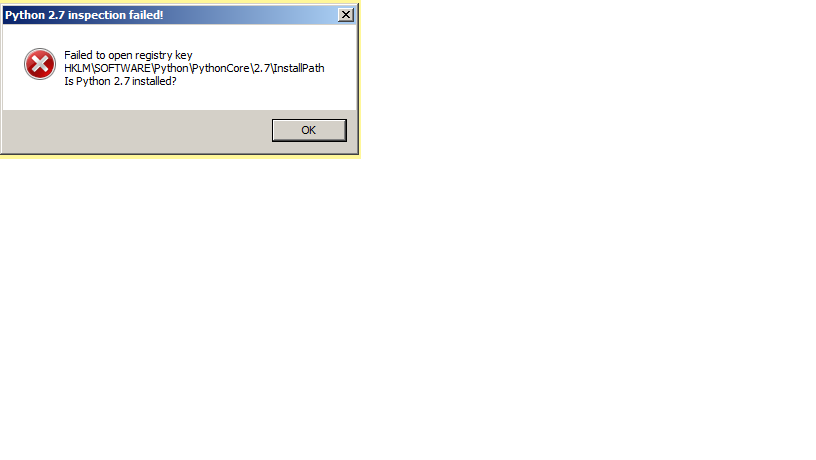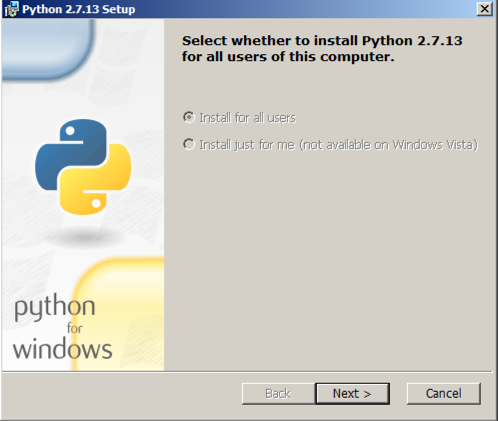Most people looking for Python 2.7.0 pc downloaded: Python myro-2.7.0. Myro is a new framework for programming robots. It is written in the language Python and designed for use in Introductory Computing courses. Pygame is free online. Released under the LGPL licence, you can create open source.

Python 2.7 is the last major release in the 2.x series, as the Python maintainers have shifted the focus of their new feature development efforts to the Python 3.x series. This means that while Python 2 continues to receive bug fixes, and to be updated to build correctly on new hardware and versions of supported operated systems, there will be. I want to create a virtual environment using python 2.7. Python 3.7.2 was default one in my computer environment. So I changed it in path environment variable to python 2.7.15. After that also while using pipenv, python uses python 3.7.2. Can anyone help me, how can I use python 2.7.15 in this case? In Python 2.7, a new means of configuring logging has been introduced, using dictionaries to hold configuration information. This provides a superset of the functionality of the config-file-based approach outlined above, and is the recommended configuration method for new applications and deployments. POSIX users (Linux, BSD, etc.) are strongly encouraged to install and use the much more recent subprocess32 module instead of the version included with python 2.7. It is a drop in replacement with better behavior in many situations. PEP 324 – PEP proposing the subprocess module.
Introduction¶

Although Python's extensive standard library covers many programming needs,there often comes a time when you need to add some new functionality to yourPython installation in the form of third-party modules. This might be necessaryto support your own programming, or to support an application that you want touse and that happens to be written in Python.
In the past, there has been little support for adding third-party modules to anexisting Python installation. With the introduction of the Python DistributionUtilities (Distutils for short) in Python 2.0, this changed.
This document is aimed primarily at the people who need to install third-partyPython modules: end-users and system administrators who just need to get somePython application running, and existing Python programmers who want to add somenew goodies to their toolbox. You don't need to know Python to read thisdocument; there will be some brief forays into using Python's interactive modeto explore your installation, but that's it. If you're looking for informationon how to distribute your own Python modules so that others may use them, seethe Distributing Python Modules manual.
Best case: trivial installation¶
In the best case, someone will have prepared a special version of the moduledistribution you want to install that is targeted specifically at your platformand is installed just like any other software on your platform. For example,the module developer might make an executable installer available for Windowsusers, an RPM package for users of RPM-based Linux systems (Red Hat, SuSE,Mandrake, and many others), a Debian package for users of Debian-based Linuxsystems, and so forth.

Python 2.7 Install Pip
In that case, you would download the installer appropriate to your platform anddo the obvious thing with it: run it if it's an executable installer, rpm--install it if it's an RPM, etc. You don't need to run Python or a setupscript, you don't need to compile anything—you might not even need to read anyinstructions (although it's always a good idea to do so anyways).

Python 2.7 is the last major release in the 2.x series, as the Python maintainers have shifted the focus of their new feature development efforts to the Python 3.x series. This means that while Python 2 continues to receive bug fixes, and to be updated to build correctly on new hardware and versions of supported operated systems, there will be. I want to create a virtual environment using python 2.7. Python 3.7.2 was default one in my computer environment. So I changed it in path environment variable to python 2.7.15. After that also while using pipenv, python uses python 3.7.2. Can anyone help me, how can I use python 2.7.15 in this case? In Python 2.7, a new means of configuring logging has been introduced, using dictionaries to hold configuration information. This provides a superset of the functionality of the config-file-based approach outlined above, and is the recommended configuration method for new applications and deployments. POSIX users (Linux, BSD, etc.) are strongly encouraged to install and use the much more recent subprocess32 module instead of the version included with python 2.7. It is a drop in replacement with better behavior in many situations. PEP 324 – PEP proposing the subprocess module.
Introduction¶
Although Python's extensive standard library covers many programming needs,there often comes a time when you need to add some new functionality to yourPython installation in the form of third-party modules. This might be necessaryto support your own programming, or to support an application that you want touse and that happens to be written in Python.
In the past, there has been little support for adding third-party modules to anexisting Python installation. With the introduction of the Python DistributionUtilities (Distutils for short) in Python 2.0, this changed.
This document is aimed primarily at the people who need to install third-partyPython modules: end-users and system administrators who just need to get somePython application running, and existing Python programmers who want to add somenew goodies to their toolbox. You don't need to know Python to read thisdocument; there will be some brief forays into using Python's interactive modeto explore your installation, but that's it. If you're looking for informationon how to distribute your own Python modules so that others may use them, seethe Distributing Python Modules manual.
Best case: trivial installation¶
In the best case, someone will have prepared a special version of the moduledistribution you want to install that is targeted specifically at your platformand is installed just like any other software on your platform. For example,the module developer might make an executable installer available for Windowsusers, an RPM package for users of RPM-based Linux systems (Red Hat, SuSE,Mandrake, and many others), a Debian package for users of Debian-based Linuxsystems, and so forth.
Python 2.7 Install Pip
In that case, you would download the installer appropriate to your platform anddo the obvious thing with it: run it if it's an executable installer, rpm--install it if it's an RPM, etc. You don't need to run Python or a setupscript, you don't need to compile anything—you might not even need to read anyinstructions (although it's always a good idea to do so anyways).
Of course, things will not always be that easy. You might be interested in amodule distribution that doesn't have an easy-to-use installer for yourplatform. In that case, you'll have to start with the source distributionreleased by the module's author/maintainer. Installing from a sourcedistribution is not too hard, as long as the modules are packaged in thestandard way. The bulk of this document is about building and installingmodules from standard source distributions.
The new standard: Distutils¶
If you download a module source distribution, you can tell pretty quickly if itwas packaged and distributed in the standard way, i.e. using the Distutils.First, the distribution's name and version number will be featured prominentlyin the name of the downloaded archive, e.g. foo-1.0.tar.gz orwidget-0.9.7.zip. Next, the archive will unpack into a similarly-nameddirectory: foo-1.0 or widget-0.9.7. Additionally, thedistribution will contain a setup script setup.py, and a file namedREADME.txt or possibly just README, which should explain thatbuilding and installing the module distribution is a simple matter of running
Python 2.7 End Of Life
If all these things are true, then you already know how to build and install themodules you've just downloaded: Run the command above. Unless you need toinstall things in a non-standard way or customize the build process, you don'treally need this manual. Or rather, the above command is everything you need toget out of this manual.
Python 2.7
Release Date: April 20, 2020
Python 2.7.18 is the last release of Python 2.
Python 2.7.10
| Version | Operating System | Description | MD5 Sum | File Size | GPG |
|---|---|---|---|---|---|
| Gzipped source tarball | Source release | 38c84292658ed4456157195f1c9bcbe1 | 17539408 | SIG | |
| XZ compressed source tarball | Source release | fd6cc8ec0a78c44036f825e739f36e5a | 12854736 | SIG | |
| macOS 64-bit installer | Mac OS X | for OS X 10.9 and later | ce98eeb7bdf806685adc265ec1444463 | 24889285 | SIG |
| Windows debug information files | Windows | 20b111ccfe8d06d2fe8c77679a86113d | 25178278 | SIG | |
| Windows debug information files for 64-bit binaries | Windows | bb0897ea20fda343e5179d413d4a4a7c | 26005670 | SIG | |
| Windows help file | Windows | b3b753dffe1c7930243c1c40ec3a72b1 | 6322188 | SIG | |
| Windows x86-64 MSI installer | Windows | for AMD64/EM64T/x64 | a425c758d38f8e28b56f4724b499239a | 20598784 | SIG |
| Windows x86 MSI installer | Windows | db6ad9195b3086c6b4cefb9493d738d2 | 19632128 | SIG |

